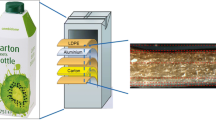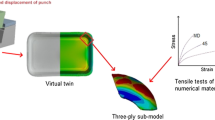Summary
Deflection under 4-point bending of a range of board types was measured for up to six months. Results were obtained under steady-state conditions of stress level (30%, 45%, 60%, 67.5% and 75% of the short term breaking stress), relative humidity (30%, 65% and 90% rh) and temperature (10°C, 20°C and 30°C). These results are presented in terms of relative creep and creep modulus. The relative creep for all board types increased with increasing stress level, increasing relative humidity and increasing temperature. An analysis of variance investigating variations between materials showed significant differences in relative creep. When the relative creep of all materials was compared over all conditions and all stress levels, plywood and waferboard had consistently low relative creep values. High alkaline cured PF chipboard and non-British Standard UF chipboard had consistently high relative creep values. The creep modulus of MUF bonded chipboard decreased with increasing log10 (time) under all conditions. Creep modulus also decreased with increasing stress level.
Similar content being viewed by others
References
Armstrong, L. D.; Grossman, P. U. A. 1972: The behaviour of particleboard and hardboard beams during moisture cycling. Wood Sci. Technol. 6: 128–137
Davidson, R. W. 1962: The influence of temperature on creep of wood. Forest Prod. J. 12: 377–381
Dinwoodie, J. M.; Paxton, B. H.; Pierce, C. B. 1981: Creep in chipboard. Part 3. Initial assessment of the moisture content and level of stressing on rate of creep and time to failure. Wood Sci. Technol. 15: 125–144
Dinwoodie, J. M. W.; Pierce, C. B.; Paxton, B. H. 1984: Creep in chipboard. Part 4. The influence of temperature and moisture content on the creep behaviour of a range of boards at a single stress level. Wood Sci Technol. 18: 205–224
Gnanaharan, R.; Haygreen, J. 1979: Comparison of the creep behaviour of basswood waferboard to that of solid wood. Wood a. Fiber 11 (3): 155–170
Gressel, P. 1972: Effect of time, climate and loading on the creep behaviour of wood based materials. Part I. Previous investigations, test plan and research methods. Part II. Test results dependent on the creep parameters. Part III. Discussion of results. Holz Roh-Werkstoff 30: 259–266, 347–355, 479–488.
Gressel, P. 1984: Long term particleboard performance under load. In 42nd Meeting of the Technical Commission of the European Federation of Associations of Particleboard Manufacturers. Reports and Discussion. pp. 62–78.
Hall, H.; Haygreen, J. 1978: Flexural creep of 5/8 inch particleboard and plywood during two years of concentrated loading. Forest Prod. J. 28 (6): 19–22
Halligan, A. F.; Schniewind, A. P. 1972: Effect of moisture on physical and creep properties of particleboard. Forest Prod. J. 22 (4): 41–48
Haygreen, J.; Hall, H.; Yang, K-N.; Sawicki, R. 1975: Studies of flexural creep behaviour in particleboard under changing humidity conditions. Wood. Fiber 7 (2): 74–90
Hirai, N.; Maekawa, T.; Nishimura, Y.; Yamano, S. 1981: The effect of temperature on the bending creep of wood. J. Japan. Wood Res. Soc. 27: 703–706
Kingston, R. S. T.; Budgen, B. 1972: Some aspects of the rheological behaviour of wood. Part IV. Non-linear behaviour at high stresses in bending and compression. Wood Sci Technol. 6: 230–238
Kratz, W. 1969: Untersuchungen über das Dauerbiegeverhalten von Holzspanplatten. Holz Roh-Werkstoff 27: 380–387
Lehmann, W. F.; Ramaker, T. J.; Hefty, F. V. 1975: Creep characteristics of structural panels. In Proceedings of the 9th International Particleboard Symposium, Pullman, Washington. pp. 151–173
Lyon, D. E.; Barnes, H. M. 1978: Time dependent properties of particleboard decking in flexure. Forest Prod. J. 28 (12): 28–33
Mc Natt, J. D.; Hunt, M. O. 1982: Creep of thick structural flakeboards in constant and cyclic humidity. Forest Prod. J. 32 (5): 49–54
Niemz, P. 1981: Nature of creep deformation of particleboards. Holztechnologie 22: 215–221
Niemz, P.; Neumüller, J. 1982: Investigation of the effect of particleboard structure on creep under long term bending loading. In Rheology of wood used in construction. 1st Session. Materials Symposium, Zielonka, 21–22 October 1982. pp. 71–84
Perkitny, T.; Perkitny, J. 1966: Comparative evaluations of the deformation of wood particleboard and fibreboard for long duration constant bending loading. Holztechnologie 7 (4): 265–270.
Sawabe, O. 1974: Studies on the thermal softening of wood III. Effects of temperature on the bending creep of dry Hinoki wood. J. Japan. Res. Soc. 20: 517–522
Schaffer, E. L. 1982: Influence of heat on the longitudinal creep of dry Douglas fir. In Structural uses of wood in adverse environments. Meyer, R. W.; Kellog, R. M. (eds). pp. 20–52 New York: Van Nostrand Reinhold
Schober, B. 1987: Studies of the effect of loading on creep behaviour of solid wood and particleboards. Holztechnologie 28: 13–16
Sekino, N.; Suzuki, M. 1984: Swelling and creep of isocyanate-bonded orientated particleboard. J. Japan. Wood Res. Soc. 30: 17–22
Wang, S. Y.; Shen, F. 1976: Studies on the bending creep behaviour of particleboard. Bulletin of the Experimental Forest, National Taiwan University. 118: 111–131
Author information
Authors and Affiliations
Additional information
The statistical analysis in this paper was performed by Anne Hasted and Laura New of the Statistical Services Centre, Reading University
Rights and permissions
About this article
Cite this article
Dinwoodie, J.M., Robson, D.J., Paxton, B.H. et al. Creep in chipboard. Wood Sci.Technol. 25, 225–238 (1991). https://doi.org/10.1007/BF00223473
Received:
Issue Date:
DOI: https://doi.org/10.1007/BF00223473




